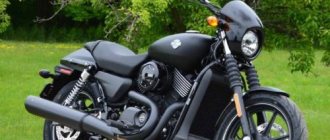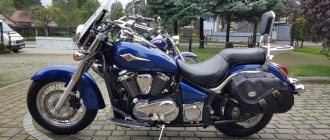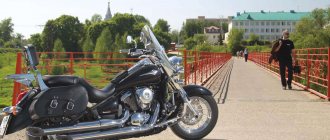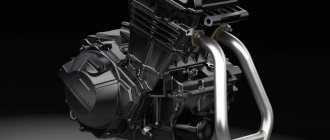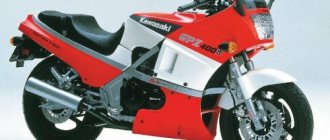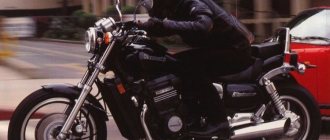There are motorcycles that were ahead of their time. In a way, the Kawasaki EN 500 Vulcan is one of those bikes. An engine was installed on it, which later found application on modern models, such as the Vulcan S. Well, in general, the car, at least, did not lag behind its competitors.
This motorcycle is for export and was not produced in Japan itself. In fact, this model is closely related to the EN 400 Vulcan from the same concern. The latter was based on the export bike 454 LTD, and at the same time it became the basis for the EN 500. The bike was produced from 1990 until 2009, which in itself indicates great demand and solid parameters of the model.
Engine
The main pride of the EN 500 is its engine. Thanks to him, the steel beast accelerates to 100 kilometers per hour in just 6.7 seconds! Peak torque is 45 Newton meters at 6,000 rpm, while maximum power is 46 horsepower at 8,000 rpm.
The engine displacement reaches 498 cubic centimeters. The engine type is in-line, two-cylinder, four-stroke. Unlike the EN 400, this Vulcan consumes only 4.7 liters per 100 kilometers, making it an economical choice.
CONTENT
- 1 History of the 1.1 model 1984–2006: Vulcan 750 series
- 1.2 1986–2004: Vulcan 400 series
- 1.3 1990–2009: Vulcan 500 series
- 1.4 2015-present: Vulcan 650 S Series
- 1.5 1987–2008: Vulcan 1500 series
- 1.6 1995–2006: Vulcan 800 series
- 1.7 2002–2008: Vulcan 1600 series
- 1.8 2004-2010: Vulcan 2000 series
- 1.9 2006–present: Vulcan 900 series
- 1.10 2009-present: Vulcan 1700 series
Dimensions and weight
The motorcycle reaches a length of 2320 millimeters and a height of 1125 millimeters. This makes it comfortable for larger people. The width of the bike is 830 millimeters, and the height of the saddle is 715. The dimensions of its wheelbase reach 1595 millimeters.
In terms of mass, the EN 500 is slightly heavier than the EN 400 and weighs 214 kilograms. This is partly due to the large gas tank volume of 15 liters. However, it is worth it, because the motorcycle is designed for long journeys, and refueling is not a frequent occurrence.
Links[edit]
- ^ a b
https://www.kawasaki.com/products/2020-Vulcan-S-ABS?cm_re=MPP-_-PRODUCTTRIMLIST-_-VEHICLEDETAILS#specs-scroll/ - https://gorollick.com/articles/consumer/2019-kawasaki-vulcan-s-review-and-test-ride-japanese-muscle-bikes/
- https://www.motorcycledaily.com/2001/08/31aug01kawasaki2002meanstreak/
- Jump up
↑ Kawasaki 2003 Vulcan 1600 Classic: MD Ride Review. Archived August 21, 2008, at the Wayback Machine. - MD First Ride: 2005 Kawasaki Vulcan 1600 Nomad Archived October 13, 2008 at the Wayback Machine
- 2004 Kawasaki 1600 Mean Streak: MD Ride Review Archived August 4, 2008 at the Wayback Machine
- ^ a b c d
"Motorcycle Road Test: 2004 Kawasaki Vulcan 2000". Motorcyclist. February 24, 2009. Retrieved July 7, 2021. - ^ a b
https://motorcyclereviews.com/2018-kawasaki-vulcan-900-classic-lt-custom-review-specs-cruiser/ - 2006 Kawasaki Vulcan 900 Classic Introduced Archived 2008-10-24 at the Wayback Machine
- MD First Ride: 2006 Kawasaki Vulcan 900 Classic and Classic LT Archived September 16, 2008 at the Wayback Machine
- Kawasaki Introduces 1700s Vulcan Trio Archived September 24, 2008 at the Wayback Machine
Chassis and brakes
The tubular steel frame of the motorcycle has an elegant and solid appearance. When you look at it, it’s immediately clear that this is a serious car with a claim to leadership. The design is made in the spirit of aesthetic minimalism, which only adds gloss to the design.
In terms of its suspension, the motorcycle is no different from the EN 400: at the front there is a 36 mm telescopic fork with a stroke of 150 mm; The rear suspension is represented by a pendulum version with a pair of shock absorbers, and has a stroke of 100 millimeters.
The wheels of the motorcycle are beautiful in design: they are equipped with spokes and designed to match the best examples of motorcycle classics. In terms of the size of its rear and front tires, the motorcycle is the same as its half-brother EN 400: 100/90-19 at the front and 140/90-15 at the rear.
The handlebar allows you to control the bike well on the road, which is facilitated by its medium size, proportional to the dimensions of the motorcycle. Round mirrors will appeal to connoisseurs of retro style. The car starts with transistor ignition.
As in the notorious four-hundredth Vulcan, there are rear drum brakes and one three-hundred-millimeter disc with a single-piston caliper at the front. You don't need anything more for such a car.
Kawasaki EN500 Vulcan: 1990 – present vr. $3000–6000An old-timer on the market, which debuted back in 1990. It’s not a remarkable device in any way (well, except for a purebred motor from a sportbike). One of many representatives of the “custom” class.
Engine The engine , ancient as death, migrated entirely from the GPZ500 (and onto that one by amputating the cylinders from the legendary GPZ900) without the slightest change, along with the whole bunch of diseases. When buying a motorcycle, you should pay attention to the level of vibrations. It can depend on many things: the quality of work and settings of the carburetors, the tightening of the bolts securing the engine to the frame, and problems with the balancer shaft adjuster. The spring in the balance shaft drive chain tension system tends to stretch over time, and as a result, adjustment becomes impossible. Another weak point is the timing chain tensioner. The tensioner fork is weak and not rigid. The tensioner body is made of soft material, which is why the adjusting thread is often cut off and begins to drive oil. If the tension is significantly weakened, the chain may jump over the teeth of the shafts, which leads to bending of the valves. The bent tail of the tensioner clock spring itself often breaks off, and the tensioner stops working.
transmission is not super - slurred, rough and noisy. In general, the unit does not shine with reliability, as does the clutch.
Frame and body kit Due to the advanced age of most motorcycles, problems in the operation of the electrical system due to oxidizing contacts are very likely. As with any chopper, it is very expensive to fall on the Vulcan - the headlight breaks, the muffler gets peeled off, the steering wheel bends, the tank gets wrinkled.
Suspension The front fork, even by class standards, is very soft and weak. The fork guide bushings wear out very quickly, as a result of which play appears in the joint of the stays, and the fork seals begin to “die” quickly. Age and poor quality chrome plating of shock absorber feathers and rods give rise to extensive corrosion of the working surfaces of shock absorbers.
Brakes The single-piston front caliper and rear drum brake, working simultaneously, have sufficient power, but an attempt at emergency braking reveals the weakness of the fork, which simply twists under braking.
Comfort Typical small cruiser, comfortable only for people of small or average height.
Modifications In 1997, the motorcycle was deeply redesigned, receiving many changes to the chassis and transmission. The characteristics of the motor were changed, making it more suitable for a chopper rather than a sportbike. The design has also been redesigned.
options
Engine : 499 cm3, 4-stroke, 2-cylinder, DOHC, 8 valves, liquid cooling Maximum power : 50 hp at 8500 rpm Maximum torque : 43 Nm at 7300 rpm Wheelbase : 1595 mm Load weight : 200 kg Front tire : 100/80–19 Rear tire : 140/90–15
Test ride of a “pocket” – Kawasaki EN500 Vulcan
WITH
The smallest of the Vulcans is the Kawasaki EN500, not as sophisticated as the 1500, but it also costs much less. Anyone with an extra $5,000 can probably afford such a motorcycle. In addition, it has been produced for quite a long time, which is a good plus.
D
This little Vulcan sees an in-line, two-cylinder engine, which is also installed on the EX500 sportbike. The balancer shafts used in this engine ensure a smooth ride in the high rpm range. At idle, the engine is slightly rough, emitting a barely noticeable vibration. Maybe this was done intentionally: many people really like to feel the life and breath of their motorcycle in this way.
P
Once you start revving the engine from idle, although there is no tachometer to help you know how many revolutions the engine is currently producing, the surprise that awaits you is how quickly the bike takes off and accelerates to a fairly high speed. maximum speed.
U
Handling of the motorcycle is a four, according to the cruiser handling scale. Of course, the Vulcan is not a sportbike, God forbid... The thin 21″ front wheel, thick rear tires and large wheelbase require that when making a snake, you mean that this is a cruiser and don’t bury yourself. The small ground clearance only aggravates this impression: when laying down the motorcycle, the footpegs and heels begin to scrape, sparks fly in different directions, the asphalt is ruined, fashionable shoes are hopelessly lost, but it still won’t fit... You will feel when you need to stop experimenting only when the motorcycle half hidden under the asphalt... Oh well - it's just a joke :). The steering of the motorcycle is very light, thanks to the unloaded front wheel, and the motorcycle is physically easy to lay down when cornering, although it does not corner brilliantly.
Of course, the Vulcan is not a sportbike, God forbid... The thin 21″ front wheel, thick rear tires and large wheelbase require that when making a snake, you mean that this is a cruiser and don’t bury yourself. The small ground clearance only aggravates this impression: when laying down the motorcycle, the footpegs and heels begin to scrape, sparks fly in different directions, the asphalt is ruined, fashionable shoes are hopelessly lost, but it still won’t fit... You will feel when you need to stop experimenting only when the motorcycle half hidden under the asphalt... Oh well - it's just a joke :). The steering of the motorcycle is very light, thanks to the unloaded front wheel, and the motorcycle is physically easy to lay down when cornering, although it does not corner brilliantly.
E
N is a great motorcycle for riding around the city, to work and to the bakery. He is friendly towards his owner, but his maintenance can cost much more than it seems. Due to the design of the timing belt, the valves need to be adjusted every 10-12 thousand km. Due to liquid cooling, liquid must be drained from the system with each adjustment. But in contrast to this, you don’t have to remove tons of plastic to get to any part.
P
The draft on the Vulcan is standard cruiser, with a soft plush seat, a high, bent-back handlebar and forward footpegs. This fit is comfortable for people of short and medium height. The motorcycle promises a high level of comfort for the passenger, using a standard backrest.
D
The engine installed on EN has been produced for quite a long time, which can guarantee its reliability and refinement. It is quite playful and high-torque despite its 500 cubic meters of volume. The new EN 500 costs approximately 5-6 thousand $ in Moscow showrooms. In my opinion, such a motorcycle is easily suitable for a girl or a beginner motorcyclist. Anyway, based on reviews from EN500 owners, this bike is not bad, although not the best.
Based on materials from Motorcycle Online
Technical characteristics of the
Kawasaki Vulcan EN500 LTD
Engine:
| EN500-C | |
| Type: | 4 stroke, 2-row |
| Volume(ss): | 498 |
| Timing system: | DOHC, 8 valves |
| Cooling system: | AND |
| Compression: | 10,2:1 |
| Diam. cylinder and piston stroke (mm): | 74×58 |
| Max. (hp) power: | 46 |
| At (rpm): | 8000 |
| Max. (n/m) critical moment: | 45 |
| At (rpm): | 6000 |
| Ignition: | digital |
| Carburetor: | Keihin CVK32 X 2 |
| Launch: | electric starter |
| Number of gears: | 6 with PNF |
| Main gear: | C |
| Clutch: | multi-disc in oil bath |
| Frame: | duplex, steel |
| Front fork: | 41 mm telescope |
| Fork angle: | 33 degrees |
| Front wheel travel: | 150 mm |
| Front wheel: | 100Х90-19 |
| Rear wheel: | 140Х90-15 |
| Rear suspension: | M, 2 adjustable shock absorbers |
| Rear wheel travel: | 100 mm |
| Front brake: | D, 1-piston caliper |
| Rear brake: | B |
| Base (mm): | 1595 |
| Length (mm): | 2320 |
| Width (mm): | 830 |
| Height (mm): | 1125 |
| Seat height (mm): | 715 |
| Ground clearance (mm): | 150 |
| Dry weight (kg): | 199 |
| Tank volume (l): | 15 |
Conventions used in this table:
VT
— fuel injection;
D
— disc brake;
B
— drum brake;
T
- telescopic fork;
M
- pendulum suspension;
MCP
- pendulum with central Uni Track monoshock absorber;
C
- chain drive;
K
- drive shaft transmission;
R
- belt;
F
- liquid cooling;
ONS,4
- camshaft in the cylinder head, 4 valves per cylinder;
2ONS,4
- 2 camshafts 4 valves per cylinder;
V2-4
- v-shaped engine, 2 cylinders, four-stroke;
RYAD2-4
is an in-line, two-cylinder, four-stroke engine.
| Get Flash to see this player. |
For whom is this the “youngest” of the Vulcans. It has been produced since 1990, and in popularity it can compete with any of its classmates. A very reliable and relatively inexpensive chopper with a very common in-line “kopeck piece” with liquid (!) cooling. The EN500 is a great bike for daily use. It is owner friendly, although servicing a high mileage motorcycle may cost a little more than expected. This motorcycle is convenient for women, or for those starting their motorcycle journey. The engine is a 2-cylinder, 8-valve “in-line” with 46 “horses”. The same engine powers the classic ER-5, the GPZ500S sports tourer (still sold in the USA as the Ninja-5 or EX500), and even the KLE500 enduro. For use on a chopper, the motor was slightly derated (from 60 hp), smoothing out its torque characteristics. Two balancing shafts provide it with good running, right up to the highest speeds. The engine has been in production for quite a long time, which guarantees its reliability and refinement. It is very playful and high-torque, despite its small cubic capacity. But the design of the timing belt is such that the valve clearances must be checked (and adjusted) every 10 thousand kilometers. In addition to valves, the timing chain also requires attention. transmission (!) The gearbox is noisy, but reliable, although it cannot boast of very precise operation (first check the traction adjustments). But “neutral” is easily found even in static conditions. The clutch is made “with a reserve” and can only bother about 50 thousand (and even then not always, because its durability is closely related to the driving style of yours and the previous owners). Frame and body kit The frame does not shine with modern technological delights - it is a simple duplex steel frame and its rigidity is quite enough for this chopper, especially since the EN500 will not be particularly hard to corner. Brakes Considering the weight and considerable (for its class) engine power, the brakes of this chopper should have worked quite effectively. Unfortunately, you can’t expect much efficiency from the combination of a single-disc front brake with a single-piston caliper and an archaic rear drum brake. The brake rating is no higher than a “four”. The suspension is quite comfortable (as for a chopper), and depending on the load, it is still possible to adjust the rear shock absorbers according to the spring preload. Comfort The seating position is comfortable only for people of short and medium height. The level of passenger comfort is quite high, provided that there is at least a standard backrest (optional).
Owner's opinion: Alexander Shats Operated this motorcycle for two seasons. At first I was worried that a chopper for daily trips around the city would not be the best option, but my fears were not confirmed. And how playful he is! The motorcycle, despite the fact that it still weighs quite a bit, is very easy to steer not only in a straight line, but also in turns. Although, of course, it behaves better on the highway than in the city. The motorcycle turned out to be a chopper in terms of landing, but it steered and accelerated like a good road bike. He gave me the opportunity to understand what kind of money I needed. And we (he and I) really don’t like speed bumps and other “tuning” of the road surface - the reason for this is the low ground clearance. Why did I sell it? Yes, probably because the previous owners also sold it: I “grew out of it.” But he gave me certain useful skills, as a beginner, for which I am very grateful to him. Who bought it? Also a newbie. At least for now...
Kawasaki EN500 Vulcan
Kawasaki EN500 Vulcan: 1990 – present vr. $3000–6000
An old-timer on the market, which debuted back in 1990. It’s not a remarkable device in any way (well, except for a purebred motor from a sportbike). One of many representatives of the “custom” class.
Engine The engine , ancient as death, migrated entirely from the GPZ500 (and onto that one by amputating the cylinders from the legendary GPZ900) without the slightest change, along with the whole bunch of diseases. When buying a motorcycle, you should pay attention to the level of vibrations. It can depend on many things: the quality of work and settings of the carburetors, the tightening of the bolts securing the engine to the frame, and problems with the balancer shaft adjuster. The spring in the balance shaft drive chain tension system tends to stretch over time, and as a result, adjustment becomes impossible. Another weak point is the timing chain tensioner. The tensioner fork is weak and not rigid. The tensioner body is made of soft material, which is why the adjusting thread is often cut off and begins to drive oil. If the tension is significantly weakened, the chain may jump over the teeth of the shafts, which leads to bending of the valves. The bent tail of the tensioner clock spring itself often breaks off, and the tensioner stops working.
transmission is not super - slurred, rough and noisy. In general, the unit does not shine with reliability, as does the clutch.
Frame and body kit Due to the advanced age of most motorcycles, problems in the operation of the electrical system due to oxidizing contacts are very likely. As with any chopper, it is very expensive to fall on the Vulcan - the headlight breaks, the muffler gets peeled off, the steering wheel bends, the tank gets wrinkled.
Suspension The front fork, even by class standards, is very soft and weak. The fork guide bushings wear out very quickly, as a result of which play appears in the joint of the stays, and the fork seals begin to “die” quickly. Age and poor quality chrome plating of shock absorber feathers and rods give rise to extensive corrosion of the working surfaces of shock absorbers.
Brakes The single-piston front caliper and rear drum brake, working simultaneously, have sufficient power, but an attempt at emergency braking reveals the weakness of the fork, which simply twists under braking.
Comfort Typical small cruiser, comfortable only for people of small or average height.
Modifications In 1997, the motorcycle was deeply redesigned, receiving many changes to the chassis and transmission. The characteristics of the motor were changed, making it more suitable for a chopper rather than a sportbike. The design has also been redesigned.
2008 Kawasaki Vulcan 500 LTD
INTRODUCTION
2008 KAWASAKI VULCAN 500 LTD - A SMART CHOICE FOR ANY BIKER WITH ANY WALLET
An excellent choice for those who are about to buy a motorcycle for the first time. Kawasaki's Vulcan 500 LTD is a suitable motorcycle for beginners. Low seat height, excellent power selection and an affordable price - all this together contributes to the development of riding skills.
The motorcycle is compact and easy to ride. Experienced riders appreciate the Vulcan 500 LTD's good features and comfort accessories along with its practicality, efficiency and reliability as a vehicle.
The engine on the Vulcan 500 LTD is the same as the Ninja 500R sport. No competition.
To call a motorcycle good, one engine is not enough, so I want to say that the chassis of the Vulcan 500 LTD is also very easy to use. The matte black, long, low steel frame creates a classic cruising look, and the seat, positioned just 28 inches off the ground, accommodates riders of all sizes.
The stepped seat, shortened rear fender, tank-mounted speedometer and chrome-plated spoked wheels harmonize perfectly with the styling of the Vulcan 500 LTD. You can enjoy it as is, or customize it with additional modifications from Kawasaki accessories.
CHARACTERISTICS
498cc Twin-Cylinder Engine - Compact twin-row engine based on the engine in the NINJA 500R. — Special cam profiles and a heavy-duty flywheel increase the lower limit of the developed torque.
Liquid cooling - Maintains constant operating temperature, which has a beneficial effect on engine life - Extends the engine's operating range when riding quietly and at higher power - Radiator is hidden between the lower frame tubes
Four valves per cylinder - Provides good ventilation, release of gases at higher power and high speeds - Keeps the combustion chamber compact for less knock with modern gasoline - Increases low-end torque
Automatic chain tensioner - Provides guaranteed chain operation for the required time without maintenance - Chain cams operate quietly and reliably
Gear Driven Stabilizer - Reduces engine vibration for a super-smooth ride
Six-Speed Transmission - Unlocks Engine's Full Potential
Positive Neutral Finder - When stopped, simply release the throttle in first gear to easily find neutral
CVK 32mm carburetors - Fast throttle response - Precise fuel metering ensures smooth power delivery at all engine speeds
Straight-through exhaust - Designed to expand low- and mid-range power - Retuned pipes increase low-speed pulling power
Single disc front brake - Single piston caliper provides fast, confident braking
Tank-mounted speedometer with rotating indicators and warning lights - All necessary information available at a glance - Compact design complements the motorcycle's attractive appearance
Stepped Seat - Comfortable, relaxed riding position for both driver and passenger
Chrome Spoke Wheels - Narrow front (100/90-19) and chunky rear (140/90-15) fits in well with the traditional LTD cruiser styling
SPECIFICATION
Engine type
| Inline, two-cylinder, four-stroke, DOHC |
| 498 cc cm |
| 74.0 x 58.0 mm |
| liquid |
| 10.2:1 |
| Keihin CVK32 x 2 |
| digital TCBI |
| 6-speed |
| chain |
| duplex, steel |
| 33°/5.9 in. |
| 41mm hydraulic fork / 5.9 in. |
| double hydraulic shock absorber with five-axis load adjustment / 3.9 in. |
| 100/90-19 |
| 140/90-15 |
| 62.8 d. |
| hydraulic, disc |
| mechanical, drum |
| 4.0 g. |
| 28.1 d. |
| 439 f. |
| 91.3 d. |
| 32.7 d. |
| 44.3 d. |
| 4.7 d. |
| Black |
| 12 months |
| 12, 24, 36 or 48 months |
History of changes
The bike has undergone a number of major changes, but the overall picture remains similar. Something was adjusted, something was replaced with something completely different:
- 1990 – the beginning of production, the first generation saw the light;
- 1996 – a turning point, second generation;
- 2009 is the last year of production, the model has not changed since ’96.
Technologies from the Kawasaki EN 500 Vulcan have migrated to new models of the Vulcan line. This same motorcycle is worthy of remaining in the memory of bikers, because the equipment is an example of a high-quality classic Japanese motorcycle.
Main generations of Kawasaki EN500 Vulcan:
Kawasaki EN500A Vulcan (1990-1996) - first generation. The model is distinguished by a classic appearance of the 80-90s, a forced engine, alloy wheels and a belt drive.
Kawasaki EN500C Vulcan (1996-2009) - second generation. The model has a more modern appearance, a retuned engine (less power, but better traction), spoked wheels and a chain drive. This modification may be called Kawasaki EN500 Vulcan Classic or Kawasaki Vulcan 500 LTD.
A 400 cc version was available for the domestic Japanese market - the Kawasaki EN 400 Vulcan.
The Kawasaki EN500 Vulcan model was produced until 2009 and was aimed at foreign markets - this motorcycle was not sold in Japan. In 2014, Kawasaki released the Vulcan S (EN650S), which, although it does not position itself as a successor to the Kawasaki Vulcan 500 LTD, can still be called one - an inline 2-cylinder “road” engine in the wrapping of a modern cruiser.
External links [edit]
- Media related to Kawasaki VN at Wikimedia Commons
| vteChronology of Kawasaki motorcycles, 1980s - forward » | ||||||||||
| Year Type | 1980s | |||||||||
| 1980 | 1981 | 1982 | 1983 | 1984 | 1985 | 1986 | 1987 | 1988 | 1989 | |
| Standard | (since 1976) Z650 / KZ650 | |||||||||
| (since 1976) KZ750/LTD | ||||||||||
| (since 1976) KZ1000 / LTD1000 | ||||||||||
| Z 1000 Z1-R | ||||||||||
| Z 1000 (A3 / A4 / MKII / FI / H / J / R) | ||||||||||
| Z 1100 R / R1 | ||||||||||
| Sport | GPZ1100 ('81–'82:B1/B2) | |||||||||
| GPz900R | ||||||||||
| GPz1000RX | ||||||||||
| Kawasaki Tomcat ZX-10 | ||||||||||
| GPz750 | Ninja ZX750F (pre-1990) | |||||||||
| GPz750 Turbo | ||||||||||
| Ninja 600R (pre-1997) | ||||||||||
| Tourism | (since 1979) KZ1300/Voyager | |||||||||
| GTR1000 Concours (pre-2007) | ||||||||||
| Cruiser | 454 LLC | |||||||||
| EL250 | ||||||||||
| Catcher ZL900 / ZL1000 | ||||||||||

